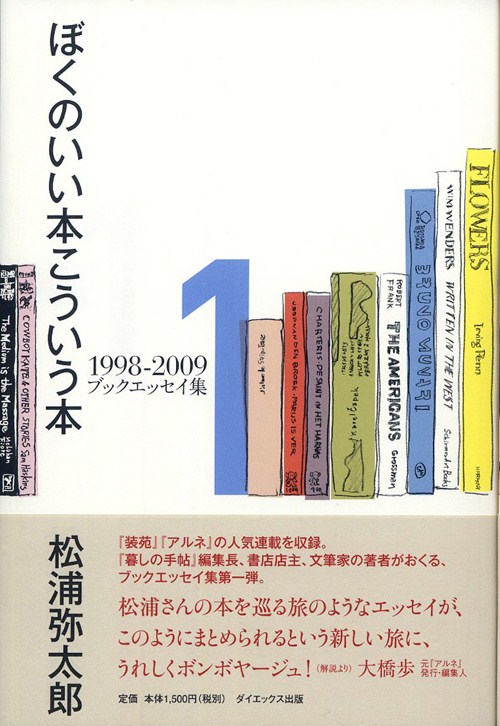ぼくのいい本こういう本1 : 1998-2009 ブックエッセイ集 by 松浦弥太郎[Boku no ii hon kou iu hon 1 : 1998-2009 Book Essays] by Yataro Matsuura (DAI-X出版)
I have a standard New Year’s Resolution that hasn’t changed in the past few years. My goal is to read at least one hundred books. This year, I have also added to my resolution to read more books in Japanese. Before you drop your jaws in awe, I must admit, this includes photography books, children’s books, graphic novels, and literary magazines. But do you ever find yourself between books and can’t decide what to read next? It’s at times like this when books full of essays about books come in handy.
For English publications, there’s always the New York Times Bestseller list but I much prefer Nick Hornby’s column, Stuff I’ve Read, in the Believer, (http://www.believermag.com/)because it has more eclectic offerings. His book essays have also been collected into three series of books.
However, not being too familiar with the kinds of title that I might find interesting in Japanese, I discovered this title, Boku no ii hon, kou iu hon, which translates to My Favorite Books are Books Like These. The essays are arranged into eight sections with chapter titles such as “Books for women are not yet an adult but not a child”, “Books that lit the fire of my wanderlust”, “Literature as a friend”, “Books for people who want to live romantically” and of course a chapter is featured with the main title of the book – “My favorite books are books like these.”
Yataro Matsuura is the editor-in-chief of a magazine called Kurashi no Techo which translates to Notes on Living. He also owns a book store and is a writer. He got his start in the book business in 1994 by re-selling foreign magazines. In 2000, he started a mobile (on wheels) book shop and finally in 2003 opened Cow Books, which according to the website, “specializes in out-of- print books focusing on the 60s and 70s social movements, progressive politics, Protest, the Beat Generation, and first editions of forgotten modern authors.”
His book is the first volume of a collection of his book essays that he has written for magazines. As I read it, I discovered that Matsuura’s taste in books is similar to my own. He features a vast array of visual books including photography, art, design and interior decoration, children’s books, cookbooks (which are more than just books with recipes) and a lot of books and zines published by small independent presses.
Since this is a Japanese book, Matsuura also features English titles translated into Japanese. Some of his favorite authors seem to be Jack Kerouac, Richard Brautigan, and Paul Auster. Kerouac’s Japanese translation of On the Road was a life- changing book for him. Shortly after reading it, Matsuura became inspired to travel across the USA as well, even though he had no plans on what he was going to do once he got there. Reading these essays has perked my interest in reading those authors as well (even if a lot of people say On the Road is overrated).
One of the books Matsuura features and which captured my interest is Chairo no Asa or Brown Morning. (I discovered that the original was a French book titled Matin Brun by Franck Pavloff, with new art by Vincent Gallo for the Japanese edition. I may have to look for an English edition of that book.) I also want to go in search of a Japanese children’s book titled Yakareta Sakana or The Grilled Fish, about a grilled fish lying on a white plate yearning to go back to the sea.
Before reading Matsuura, I was between books and couldn’t decide what to read next; now he’s given me so many more titles to choose from that it makes selecting the next book just as difficult! Perhaps I should read the second volume of Matsuura’s book of book essays before choosing another title? by Ernie Hoyt
This book is available only in Japanese.

